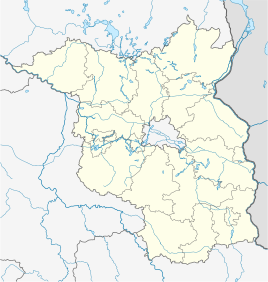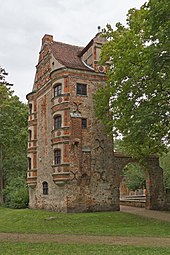Freyenstein
|
Freyenstein
City of Wittstock / Dosse
|
||
|---|---|---|
| Coordinates: 53 ° 17 ′ 14 " N , 12 ° 21 ′ 14" E | ||
| Height : | 81 m | |
| Area : | 34.16 km² | |
| Residents : | 808 (Jun. 30, 2018) | |
| Population density : | 24 inhabitants / km² | |
| Incorporation : | October 26, 2003 | |
| Postal code : | 16909 | |
| Area code : | 033967 | |
|
Location of Freyenstein in Brandenburg |
||
Freyenstein is a titular town in the north of the Brandenburg Prignitz . Since October 26, 2003, Freyenstein has been part of the city of Wittstock / Dosse due to the integration contract of January 21, 2002 . The place had 808 inhabitants on June 30, 2018.
history
13th century to 19th century
Freyenstein was first mentioned in 1263 as Virgenstene . The place was founded as a Brandenburg border fortress against Mecklenburg , but it was subsequently destroyed several times during armed conflicts. In 1287 the princes of Werle decided to rebuild the city a little further to the northeast. In the same year she received city charter, the council college and jurisdiction. The former urban area, which extends over an area of around 25 hectares , was then primarily used for agriculture. In 1309 the Order of St. John received church patronage over the city church. This was consecrated in 1325 in honor of Saint Mary . The existence of a moated castle was first recorded in 1332.
In a document dated March 14, 1462, issued in Tangermünde , Dietrich and his cousin Hans von Plessen confess that they and their male heir Margrave Friedrich the Younger of Brandenburg , also called the Fette, castle and town of Freyenstein as well as the villages of Grabow and Rosenwinkel sold with all accessories for 950 Rhenish guilders as a hereditary man fief . In 1492 von Rohr took over the city and with it the jurisdiction over its inhabitants. Towards the end of the 15th century they built the fortress next to the existing castle complex . In 1556, craftsmen built a Renaissance style castle on the site of the former moated castle . At the end of the Thirty Years War Freyenstein was almost completely depopulated. During this time the von Rohrs got into debt and had to hand over the place to the von Winterfeldt . In 1652 the plague brought down all other residents of the place with the exception of 28 people. Then the castle fell into disrepair. The church was poorly repaired by craftsmen in 1703. They replaced the gable , which had previously been artistically decorated with panels , with a simple component made of brick . In 1718 the church was destroyed by fire. The parish rebuilt the sacred building - but in 1812 there was another fire in the church. In 1863 a men's gymnastics club was founded. In 1892 the teacher Rudolf Rietz published a scientific paper on the flora of the region. It contained 612 species of plants, including six species of orchids. A volunteer fire brigade was founded in 1892.
20th and 21st centuries
In 1907, craftsmen built the first sidewalks on Marktstrasse. The citizen Fritz Neumann campaigned for the electrification of the city by building his own plant. In 1924 the first edition of the Freyensteiner Zeitung appeared . At the end of the Second World War , one of the death marches of concentration camp prisoners also led through the town. Refugees were quartered in the castle, after which it was used as a school from 1951 to 1964. In 1952 the first LPG Frieden was founded , initially consisting of eight members who farmed around 66 hectares. In 1964 the city opened a new Wilhelm Pieck polytechnic , while the castle was used as a school day care center. In 1980 a riding club was founded. In 1988 the city's residents celebrated their 725th anniversary. In 2003 it was incorporated into Wittstock / Dosse. The Archaeological Park opened in 2007, while the school had to close in 2008. In 2013 Freyenstein celebrated its 750th anniversary.
Sights and culture
Architectural monuments
The old town of Freyenstein is one of the best preserved medieval urban desolations in Germany and is therefore one of the most important archaeological monuments of this type in Central Europe. During excavations in the last few decades, old house foundations and cooking areas were found there. Since the area of the destroyed city was not built on again, archaeological investigations allow a precise insight into the structures of the medieval city. The Freyenstein Archaeological Park can be visited in the summer months. In its entrance building there is a small museum with finds.
- Parish church , built at the end of the 13th / beginning of the 14th century, with an altar and epitaphs
- Old castle , also called castle, built in 1556 on the old castle grounds, first the seat of the von Rohr family, then the von Winterfeld family
- New castle , built around 1650, seat of the family v. Winterfeldt
- Wittstocker Tor, medieval city gate with structure from the 2nd half of the 17th century, attached to the New Palace
Historical monuments
- Gravestone on the graves of an unknown number of prisoners of the death march from the Sachsenhausen concentration camp next to the church
- Memorial stone for six victims of the death march in the cemetery on Warnsdorfer Weg
Culture
- The American artist and musician Mykki Blanco shot a short film in 2016 in Freyenstein in collaboration with Matt Lambert .
- Several clubs are located in Freyenstein, for example the sports club MTV Freyenstein (football and volleyball), the riding club, which organizes the famous equestrian festival every year, the shooting club and the volunteer fire brigade .
- Until a few years ago there was a large campsite on the outskirts of Freyenstein, which was closed due to construction work.
Sons and daughters of the place
- Minna Cauer , (1841–1922), German educator , activist of the bourgeois women's movement
See also
literature
- Historical Gazetteer Brandenburg - Part 1 - Prignitz - A-M . Modifications made by Lieselott Enders . In: Klaus Neitmann (Ed.): Publications of the Brandenburgisches Landeshauptarchiv (State Archive Potsdam) - Volume 3 . Founded by Friedrich Beck . Publishing house Klaus-D. Becker, Potsdam 2012, ISBN 978-3-88372-032-6 , pp. 215 ff .
Web links
- Freyenstein - Website of the Freyenstein / Ostprignitz e. V.
- Freyenstein in the Duncker Collection (PDF; 248 kB) of the Central and State Library Berlin
- Freyenstein in the RBB program Landschleicher on June 17, 2018
- Romanesque routes in Berlin and Brandenburg - Freyenstein urban desert
Individual evidence
- ^ Resident of Freyenstein. Retrieved July 21, 2018 .
- ↑ Märkische Allgemeine from August 1st, 2016
- ^ StBA: Changes in the municipalities in Germany, see 2003
- ^ History and events of the city of Freyenstein , website of the Freyenstein Friends' Association, accessed on January 11, 2019.
- ^ Announcements of the Association for the History of Prignitz , Volume 4, edited by Uwe Czubatynski on behalf of the Board of Directors, Perleberg 2004, p. 173
- ↑ Christopher Clark : Prussia: Aufstieg und Niedergang 1600–1947 (= Federal Center for Political Education: series of publications, 632). Federal Agency for Political Education, Bonn, 2007, ISBN 978-3-89331-786-8 ; P. 59.
- ↑ Flyer: Experience history in Freyenstein - Tourist highlights , without dates, p. 8.
- ↑ Anne Waak: Against shame and guilt. Welt am Sonntag , June 26, 2016, accessed on February 28, 2017 .




